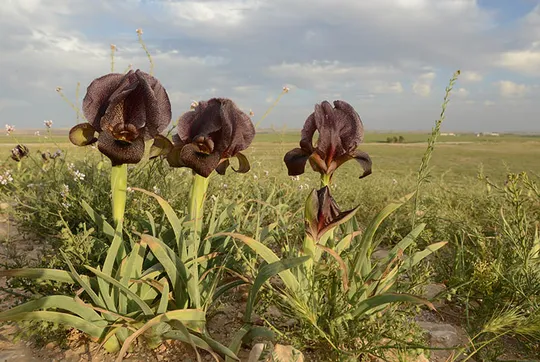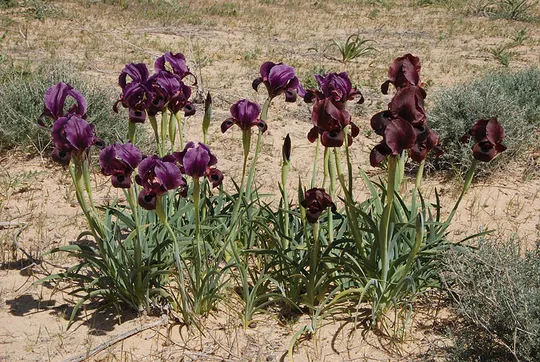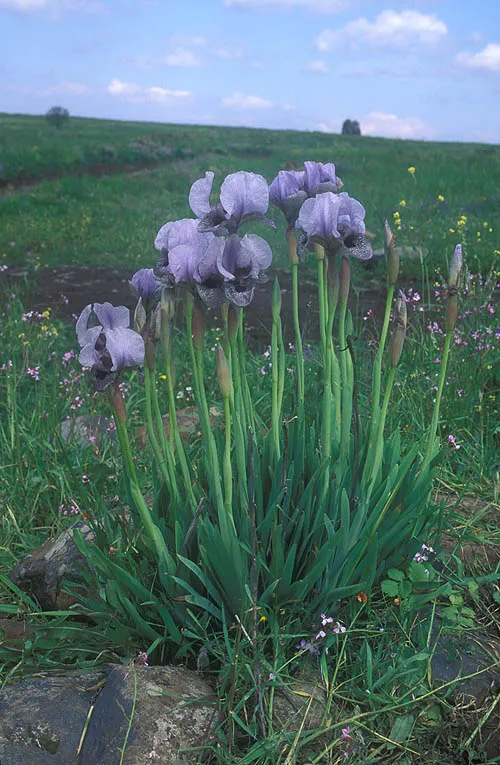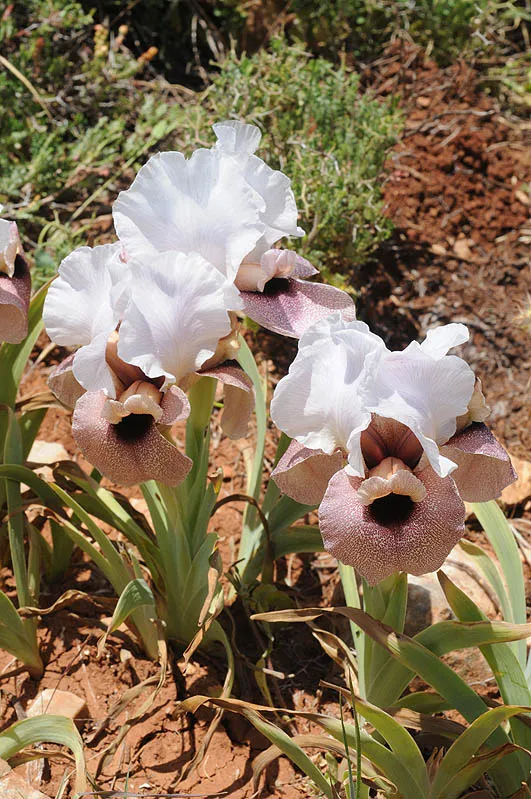Vartan's Iris
Iris vartanii

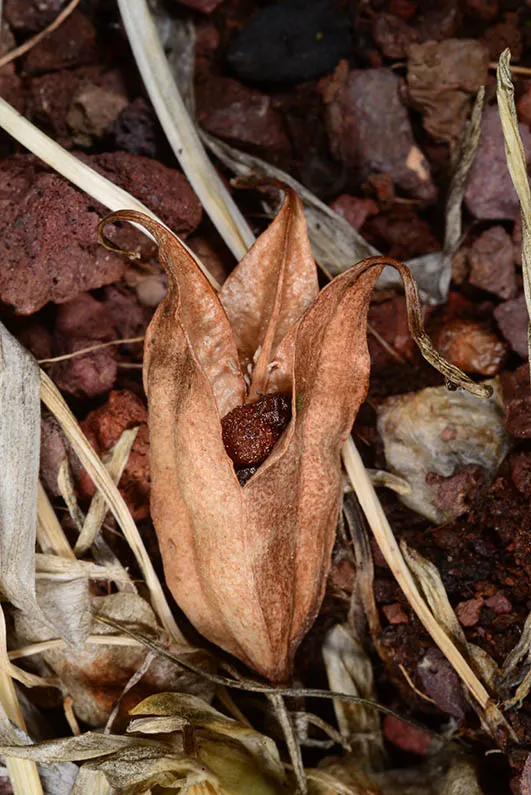


Iris vartanii is a geophyte with a single scale bulb enveloped in fibrous netlike shells. The plant is 10-20 cm tall and has a stem that bears a single flower. Its leaves are linear, with a square cross-section, pointed at the edges and usually longer than the azure flowers that are 3.5-4.5 cm across. The flower's outer perianth segment forms a lower lip shaped like a narrow, long tongue and its head is spread in the shape of an elongated ellipse, adorned with an azure striped pattern, and a prominent yellow keel at its center like a curled crest. The inner perianth segment is straight, narrow and undeveloped. The style is petal-like, extends above the lip and splits into two narrow lobes about 2 cm long. I. vartanii blooms with leaves at the height of winter from late November to early February.
The species was first described from the Nazareth Mountains. While its distribution pattern is highly localized, it is relatively common in all of Israel's hilly regions: Judean mountains, Samaria (on the Samarian semi-steppe as well according to Danin, 2004), the Carmel and the lower Galilee. It is rare in the southern Golan and Ramot Menashe. Hundreds of plants were counted on the Ma’on ridge (above 850 m), at Ba’al Hatsor and Mount Eval. In the upper Galilee, the northern Golan and the Hermon its distribution is sparse (Amud Stream, Wadi Bet HaEmek), and it is replaced there by Iris histrio. In the Hebron Hills, it is very common from Karmey Tsur to Mitspe Ya’ir, where populations of hundreds grow.
Terra rossa soil, mostly
on hard limestone on rocky slopes and between rocks at altitudes above 450
meters on the mountains; it is most abundant above 800 m. It grows with Quercus
calliprinos and Pistacia palaestina, and with Quercus boissieri
in sunny areas. In the Hebron Hills, it grows in rocky sites in the
Mediterranean-desert ecotone.
Iris vartanii, and the similar Iris histrio,
belong to a special section of the Iris genus whose leaves have a square
cross-section, and whose bulbs are wrapped in netlike fibers. Iris vartanii and
Iris histrio are vicarious species with a very similar appearance: Iris
histrio replaces Iris vartanii in the upper Galilee and in Lebanon.
The labellum of Iris histrio has small (1-1.5 cm), broad lobes, and is
covered in purple-blue spots on a background of blue veins, with a white-golden
spot at its center. The rigid yellow line along the labellum is not prominent. Iris
vartanii, on the other hand does not have dark spots on its labellum, and the
lobes of its style are narrow and long. In the upper Galilee, populations of
transition forms between Iris histrio and Iris vartanii were
identified (Cohen and Shmida, 1992).
Different Iris
vartanii populations show considerable variation in the labellum patterns
and color shades. In transition areas, there are forms of Iris vartanii whose
flower shades are very light and their color is a lively light blue. This
difference coincides partially with the differences found in Iris histrio.
Future taxonomic analysis may classify Iris vartanii as a subspecies of Iris
histrio, but this change of status will not affect the fact that this is an
endemic taxon that should be preserved.
·
Habitat destruction
presents a significant threat: in the Jerusalem area, Iris vartanii became
almost completely extinct because of road development and construction. Similar
development threatens the Nablus and Ba’al Hatsor areas and the mountainous
regions above 700 m. This is particularly true for the Ma’on ridge, where the
southernmost populations in the world grow. Development of the ridge from Susya
toward Mount Amasa will lead to their extinction.
·
The plant always grows in a
distant, isolated pattern, with 3-30 m between individuals in the population,
which prevents vegetative reproduction that can create dense colonies.
·
This is a sub-endemic
species. In areas outside Israel, there is accelerated habitat destruction of
plant communities that include Iris vartanii.
·
Protected in the Mount
Carmel Reserve, Mount Kabir Reserve, Iris bismarckiana Reserve
(Nazareth) and the Mount Tabor Reserve.
Conservation of open woodlands
and even creation of clearings in natural woodland.
Endemic to Israel,
Jordan and southern Syria. Also recorded in southern Lebanon, but it is possible
that these are transitional forms to Iris histrio. In Syria, it is found
in the Damascus basin and southern Houran, and the population we are familiar
with from the southern Golan continues eastward from there.
Sub-endemic
geophyte whose primary distribution is in Israel. It is rare and grows on
mountains, in open woodland and scrubland throughout Israel's central mountain
ridge. In the upper Galilee and the Hermon, it is replaced by its vicarious
species – Iris histrio. Development activities threaten its populations.
Current Occupancy Map
| 1000 squre meter pixel | 5000 squre meter pixel | 10000 squre meter pixel | |
|---|---|---|---|
| number of observations | 0 | 0 | 0 |
| in total pixels | 0 | 0 | 0 |
| Family | Iridaceae |
| Classification | On the endangered species list |
| Ecosystem | Mediterranean |
| Chorotype | Eastern Mediterranean |
| Conservation Site | Keren Ha’Carmel (Muhraka) and Ba’al Haztsor Mountain |
| Rarity |
1
1
6
|
|---|---|
| Vulnerability |
0
0
4
|
| Attractiveness |
0
3
4
|
| Endemism |
0
4
4
|
| Red number |
1
4.2
10
|
| Peripherality | 0 |
| IUCN category | DD EW EX LC CR EN VU NT |
| Threat Definition according to the red book | Endangered |
 Based on:
Based on:
